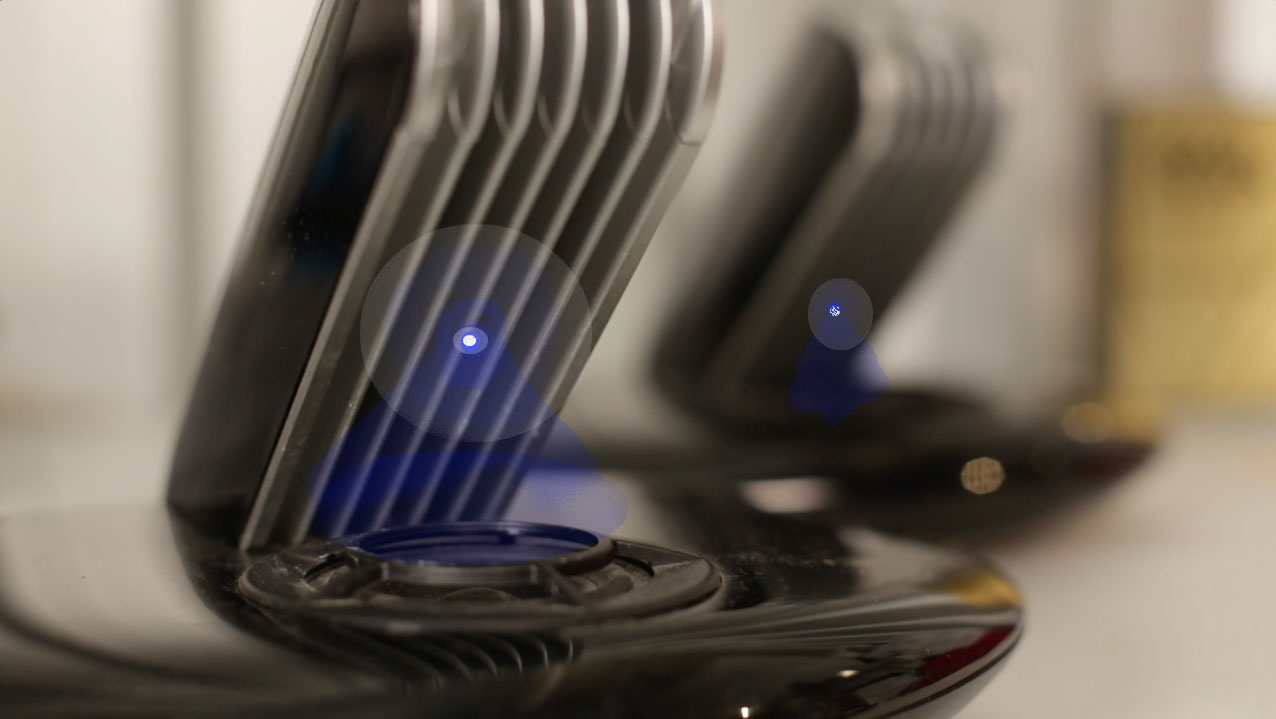Ideal Point Source
Deep Science of making the
impossible possible
Dr Toby Gifford presented DaS science to the Acoustic Engineering Society’s Burlingame Conference. The paper (featuring Dr Gifford’s mathematics) explains not only how ‘Diffusion at Source’ is achieved – but more importantly, what it does that is so different to what conventional speakers do.
“DaS technology emulates a point source: i.e. the sound-field radiates power uniformly in all directions (typically, at least up to about 70 degrees off-axis). This effectively minimises soundfield distortion from the self-interference that is typical of traditional membrane drivers. In particular, it streamlines the air-particle velocities along the direction of radiation, minimising off-axis (tangential) energy that is associated with conventional loudspeakers.
As a consequence, the spatial information encoded in stereo recording is maintained in pristine form by DaS, whereas traditional loudspeakers distort this information by confounding it with directionally confusing ‘eddies’ formed by self-interference. Such conventional loudspeaker created minor perturbations, noise if you will, appear to be audible to human audiology and hence significant to our perception.
DaS also enhances signal-to-noise ratio by enabling physically larger drivers (with their greater capacity to excite a soundfield) to behave like small ‘point sources’.

Additionally, an DaS soundfield even has advantages over the (albeit theoretical) ‘ideal point source’. Both DaS and ‘point source’ radiate power uniformly in all directions, however an DaS soundfield is directionally phase auto-decorrelated. In other words, if ϕ(θ) is the phase of the soundfield on the surface of a sphere of fixed radius around the source, at a fixed time, as a function of the azimuth angle θ, then ϕ(θ) is uncorrelated with any azimuthal rotations of itself. This is important because phase correlations give rise to phantom images when the soundfield is reflected from a hard flat surface (like a wall). Such phantom images are interpreted by the brain as reverberance, and thus overlay spatial perception of the listening room on top of the spatial information encoded in the audio (as intended by the producer). Since a sound wave reflects from a flat surface according to the angle of incidence between a surface of constant phase (i.e. a wave-front) and the normal vector of the surface, decorrelating the soundfield phase means that no coherent reflections are formed.
Thus with DaS, the spatial cues communicated to the listener are only those encoded in the recording – the direct sound, without the overlay of the particular spatial cues (typically undesirable) created by reflections caused by the geometry of the listening space.”
DaS AuReality Technology – Diffusion at Source not only mitigates against specular reflections (proven to corrupt the acoustic envelope we listen to) but also, perhaps more importantly, it enables loudspeakers to output their energy in a purely radial flow. In short, the acoustic energy of AS8 speakers travels outward in a radial pattern, whereas conventional loudpeakers create a number of ‘zones of confusion’ in which the energy flow (acoustic intensity) is not radial (i.e. toward the listener) but is tangential (think of it as a bit like the wake of a boat) – effectively robbing sounds’ pure spherical wavefront of the energy we listen for.
This ‘energy conservation’ is very important.
When all the acoustic energy is travelling radially from its source, there can be no energy travelling in a direction that might corrupt that sound-wave. This is not the case for conventional speakers, which will corrupt the sound-wave with their off-axis tangential energy (the main reason the ‘sweet spot’ of conventional speakers is so narrow).
The above is particularly pertinent to stereo/ambisonic signals, where timing cues are critical to our audiology’s ability to reconstruct the sound-stage of the original recording. Conventional speakers’ non-radial acoustic energy distribution corrupts the timing (and intensity) of such cues, leading our highly sensitive audiology to create a ‘false reality’ of the playback sound (something which we readily recognise as ‘not real’). Tangential energy locations might even appear as ‘phantom loudspeakers’, producing cues that have nothing to do with the audio signal! We’re of the opinion that this is why recordings mostly ‘sound like recordings’.
AS8 energy conservation, and much bigger sweet spot, means AS8 speakers deliver even more accurate cues when configured as a stereo pair. Add to that their autodecorrelation, which not only prevents specular reflections but reduces the ‘precedence effect’ (a psycho-acoustic effect that collapses the sound stage when one sits nearer to one speaker than the other in a stereo pair) and you may understand why DaS is so important to spatial sound – and particularly to multi-speaker surround sound.
DaS mathematical modelling shows exactly how AS8 speakers work – and exactly why conventional speakers can’t match them.
But don’t just take our word for it – do the maths yourself. We’ll share ours with you if it helps – drop us an email.
Following our latest Mathematical analysis, we are confident that DaS is the most significant contribution to the playback of recorded sound since the invention of the Dynamic Loudspeaker. In fact, all the data – and listening tests – suggests that AS8 speakers behave pretty much exactly as an ‘idealised point-source’. Whilst this has always been considered the ‘gold standard’ it has also been thought impossible – until now!
AS8 ‘acoustic apodisation’ through ‘Diffusion At Source’ enhances the listener’s perception of Intimacy, Envelopment and Clarity. Listening through DaS technology really does sound ‘like being there when the recording was made’.


